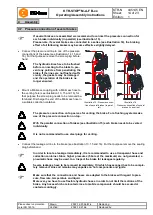
KTR-STOP
®
M-A-F B-xx
Operating/Assembly instructions
KTR-N
Sheet:
Edition:
445145 EN
10 of 23
1
Please observe protection
note ISO 16016.
Drawn:
2022-12-20 Ka/Wie
Replacing:
Verified:
2022-12-21 Ka
Replaced by:
KTR supplies brake pads free from asbestos and lead only.
If requested, we will provide you with the respective certificates.
The brake pads are each adapted to the application and delivered accordingly.
They can be distinguished as follows:
•
organic material
•
sinter metal
!
Brake pads are highly sensitive to grease and oil which means that they cannot be cleaned.
Brake pads having such kind of dirt need to be replaced and disposed of.
We would recommend to store the brake pads in their package as long as possible to pro-
tect them from any kind of dirt.
!
Brake pads which have worn off to the wear limit have to be replaced immediately. Make
sure to replace by original components only.
S T O P
In order to avoid any injuries always make use of proper lifting equipment.
!
The brake is mainly selected for mounting on vertically aligned brake disks (see illustration
3). With horizontally aligned brake disks (see illustration 1) the brake may only be aligned
upright.
There are M12 threads in the pad retainer to fasten an eye bolt serving to use lifting tools. The eye bolt is to be
dismounted after assembly of the brake and stored in a safe place.
!
In order to avoid any damages on the brake, never twist a rope or another lifting tool around
damageable components.
Before you start with the assembly check if a sensor has been mounted.
Remove it before assembly in order to avoid any damages.
•
Insert the brake pads (component 6) fully into the brake caliper.
•
Applying for the moveable side only:
Push back the brake pad and brake piston manually.
!
Please make sure that at least one screw plug (component 1.6) is removed when moving
back the brake piston. Afterwards re-assemble the screw plug.
If you want to use brake pads after having assembled the brake, it is necessary to disas-
semble the pad retainer (component 1.3 and 1.4) for that purpose (chapter 5.1).
4
Assembly
4.3 Brake pads
4.4 Assembly of the brake









































